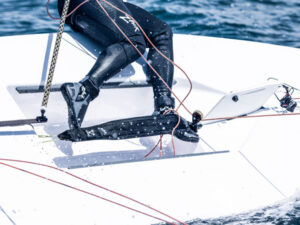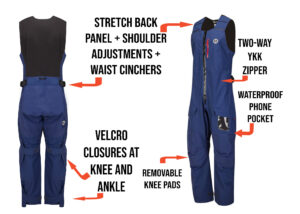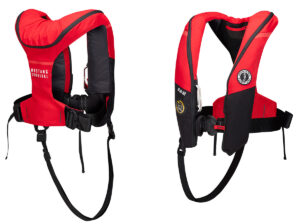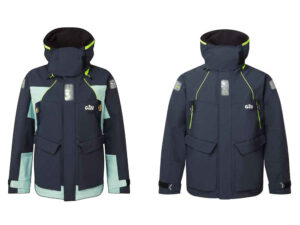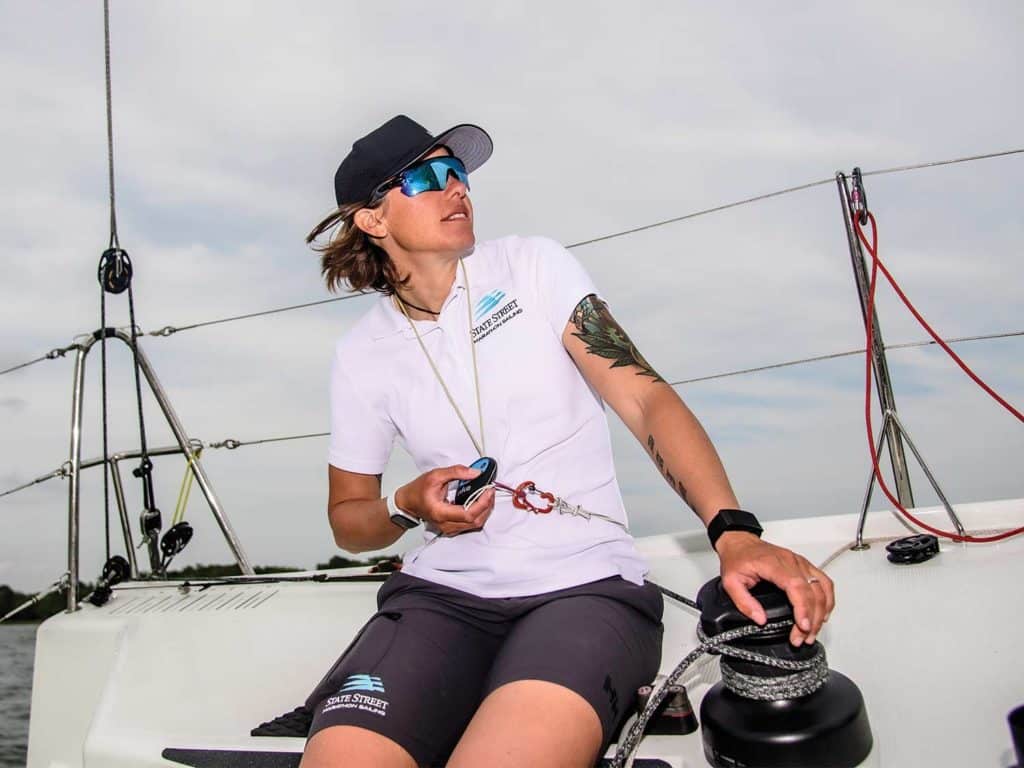
Autopilots aren’t new, but modern technology has made today’s autopilots considerably better than previous-generation offerings. Moreover, the utility that contemporary autopilots offer make them must-have equipment for doublehanded sailors racing aboard 30- to 50-footers. Here’s a look at how they work, the hardware and software involved, and the performance and safety benefits that they deliver, both for ground-up installations and refits.
Autopilots are electromechanical systems that—as their name implies—can steer a boat to a specified compass course, wind angle, waypoint or route. Unlike human drivers, autopilots never suffer concentration gaps, or get tired or scared, so long as they’re fed a steady diet of information and DC power.
While each manufacturer has its own approach to hardware and software, autopilot hardware generally consists of a processor (sometimes also called an autopilot computer), a power-supply unit, a control head, a rudder-angle sensor, networked sensors (e.g., wind, speed and depth), a drive system and—optionally—one or more remote controls. Additionally, some autopilots employ advanced sensors that are used to clean or stabilize networked sensor data to give the pilot better, more reliable information. We’ll get to that later.
Most autopilot processors and power-supply units are black boxes. The processors pull information from the system’s networked sensors and rapidly crunch the numbers needed to efficiently drive the boat. They’re networked to the control head(s) and/or the boat’s multifunction display, which serves as the system’s user interface. Power-supply units draw DC power from the boat’s battery banks and send it—as needed and as dictated by the processor—to the system’s hydraulic- or mechanical-drive system (i.e., the system’s muscle; this typically consists of a hydraulic cylinder or mechanical arm that attaches to the hull on one side and the rudder quadrant on its business end, plus a rudder-angle indicator), which actuates the rudder.
Unlike human helmsmen, autopilots can’t see what’s ahead of or behind the boat, so they leverage networked instrument data to keep the boat sailing to its specified course, wind angle or waypoint. Because of this, all autopilot systems require at a minimum a heading sensor, wind sensor and boatspeed sensor. Years ago, autopilots used fluxgate compasses for heading information. While these worked, their analog nature and sluggish reporting rates (ballpark is once per second, or 1 hertz) yielded jumpy numbers when sailing in big seas. Their inherent latency doesn’t mix well with modern processors either. Because of this, most autopilot manufacturers switched to employing solid-state, nine-axis compasses for heading sensors several years ago. These compasses provide accurate pitch, yaw and roll information (typically accurate to plus or minus 2 degrees), which they report at a rate of 10 hertz (ballpark).
Wind data is obviously critical to performance sailing, and autopilot driving is no exception. “You need a masthead unit for wind angle and windspeed,” says Mike Vellucci of EuroMarine Trading, which imports and distributes NKE marine electronics. Vellucci says this information comes in the form of apparent wind angle and apparent windspeed data. Most modern systems also use heading data from their networked compass and boatspeed from either a networked through-hull transducer to measure speed over water or their networked GPS antenna to measure speed over ground to calculate true-wind data. The autopilot system then uses this data to calculate the true wind angle, true windspeed and true wind direction. Once networked and installed, an autopilot will sail to the [wind] angle you tell it, Vellucci says. “It will do everything in its power to [hold] that [angle].”
Critically, autopilots can steer to AWAs or TWAs, depending on the situation and point of sail. Apparent wind angle is generally used when sailing upwind, when the angle is stable, Garmin’s Jon Josephson says, adding that TWA is generally preferred when autopilots are sailing downwind, both to avoid accidental jibes and to yield better performance should the wind get shifty.
Additionally, autopilots require speed-over-water sensors and a networked GPS. “The more data we can feed the pilot, the more it can do for us,” Raymarine’s Jim McGowan says.
Unlike autopilot systems of yore, most contemporary autopilot manufacturers offer high-performance sensors that can be used to remove vessel motion from heading and wind-angle information. “Pitch and roll can induce AWS,” B&G’s Matt Eeles says. “It’s noisy data.” For example, B&G’s H5000 CPU can integrate the boat’s motion and heel angle, and deliver gyro-compensated wind information, yielding stable apparent-wind readings. Likewise, Garmin, NKE and Raymarine autopilots also have the ability to scrub data for vessel movement. “When the masthead [wind] sensor moves, it throws error into the wind calculations,” McGowan says. “[Raymarine’s] EV1 sensor delivers real-time filtering and stabilization so that oscillations are removed and clean information is fed into the autopilot’s processor.”
The other significant advantage of cleaner data is reduced rudder articulation, which reduces electrical consumption and bolsters VMG. “If you put raw sensor data [into the autopilot], it will be all over the place and it will burn lots of power,” Eeles says. “You don’t want the pilot to react to every little puff or change…it risks the pilot being out of control. You also don’t want to dampen the data because this creates a lot of latency.”
Modern autopilots can also employ software to introduce some level of intelligence to automated driving. For example, most contemporary autopilots have the ability to deal with gusts and wind shifts to prevent the boat from accidentally rounding up or jibing.
“If an autopilot is sailing to a wind angle and a 5-knot gust comes, you want it to do what you’d do as a helmsman: Bear away and take the sting out,” Eeles says. While this is a great feature, Josephson reminds users to build a certain amount of margin into their user-selected parameters. “Don’t set the jibe alarm at 178 degrees,” he says. “If the wind gets behind the sail, the boom will go over.”
Josephson recommends setting the alarm at 160 degrees. “Make sure the parameter is set so it’s not on the edge,” he says.
Remote controls are the final important consideration, especially for shorthanded sailors, because they enable course changes or corrections to be made from anywhere on board rather than from a multifunction display or a control head. “It’s [my] primary pilot controller,” Eeles says.
“There are tasks that require all hands on deck,” McGowan says. “It’s not always an option to run back to the cockpit. Plus, there are also some safety considerations.”
These remotes can also provide an additional safety margin for doublehanded sailing, where man-overboard scenarios can be a true nightmare. Vellucci explains that NKE autopilots have two modes: solo and fully crewed. Sailors carry remote controls that are electronically linked to the autopilot (think geofencing); should a remote break contact with the autopilot, one of its MOB modes activates, creating an audible alarm and automatically switching the system’s graphic display(s) to a dedicated MOB page. “In solo mode, it puts the boat head-to-wind,” Vellucci says. “In crewed mode, the system displays a bearing and distance to where the MOB event occurred, [and it also] starts a timer.” (Note: The waypoint marks the latitude and longitude of where electronic contact with the remote was lost, not the MOB’s real-time location.)
These advancements offer huge benefits to doublehanded crews, but it’s critical to properly spec the system for the boat. For example, if you’re taking a J/105 that’s mostly been used for round-the-buoy racing and are adding a complete autopilot system, Josephson and McGowan both advise using vessel weight as a guide for what system to purchase. “It doesn’t matter if the boat is tiller- or wheel-driven,” McGowan says, adding that Raymarine (and other manufacturers) make autopilots for both.
You need a drive unit that works with your quadrant and the boat’s displacement, McGowan says. He also notes that most boatbuilders list the dry weight of their steeds, which doesn’t account for sails, crew, provisions or additional safety gear. In the case of a J/105, the dry displacement weight is 7,750 pounds. “We always add 20 percent, so 9,300 pounds,” McGowan says.
Josephson agrees, adding that if the boat’s racing weight is close to the maximum a drive can handle, it’s usually better to step up to a bigger drive system. Another consideration involves the number of rudders. “One drive is enough [to control a boat with two rudders],” Josephson says, adding that these boats—for example, Class 40s—typically have dual rudder quadrants and a connecting tie bar, so the autopilot drive needs to be attached to only one of the quadrants. “But the second rudder might add 50 percent of the load of the first rudder.”
Conversely, if you’re refitting a new autopilot into a boat that’s already equipped with an older autopilot system, even if it’s built by a different manufacturer, odds are good that you’ll be able to reuse pumps and drives. This is because most marine-electronics companies source their drive units from the same manufacturers, so they’re not typically proprietary. “If there’s a nameplate on the drive, take a photo of it and talk to your dealer,” McGowan says. “This can be a big money saver because drive units can be many thousands of dollars.”
While it’s theoretically possible to add—for example—a Raymarine autopilot to a B&G-, Garmin- or NKE-equipped boat, most sailors will find that it’s best to stay within the same electronics manufacturer’s (semi)walled garden because this usually allows the boat’s multifunction display to talk to—and control—the autopilot.
Another important consideration involves where the drive system is physically located. As mentioned, most autopilot drives are situated belowdecks; however, some systems are cockpit-mounted. While these systems work fine, some cockpit-mounted, tiller-driven systems can present a tripping hazard to a doublehanded team that is constantly scurrying around the boat. Because of this, below-deck drives are considered the optimal installation for doublehanded or shorthanded crews.
Irrespective of how or where your autopilot is installed, it’s critical to spend time practicing with your system and dialing in its user-configured parameters prior to hitting the racecourse. “I think the key is using it so that you understand how it works,” Josephson says. “Understanding the [user-selected] inputs can greatly affect the performance of the pilot…. [Sailors] really need to use [their autopilot], understand what it’s doing and how [parameter] changes affect its performance.”
So, if you’re interested in shorthanded racing and considering adding a modern autopilot, not only will it drive your boat with far more precision than an old-school system, but it will also do so while consuming less DC power and exerting less rudder as well.

